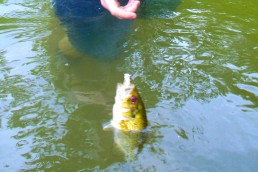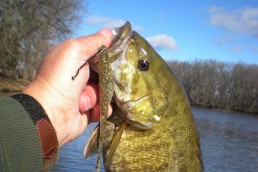Red Eyes of the Goggle-eye doesn’t mean it’s a Devil Fish
SHARE THIS POST
I can still remember my first goggle-eye—I plunked a minnow next to the gnarly roots of a swamp oak along the banks of a borrow pit at Big Oak Tree State Park in Mississippi County in Missouri. My bait disappeared as soon as the rock bass hit the water. Thoughts of big fish were the first thing to cross my mind, but the creature on my line went absolutely berserk. It ran this way, then that way and in circles. I gasped when I flung this unusual-looking fish into the bottom of our old cypress boat. The thick-shouldered bass sported deep red eyes and a blackish-green body with faint vertical stripes and its sharp spines stood up on its back.
This fish looked meaner than a junkyard dog.
My first impression of the demonic-looking fish was that it must’ve come straight from hell. Long-tanding superstitions often mixed fervently with religious inclinations in the dark, dismal swamps of southeast Missouri and Arkansas. My head had been filled full of ideas about witches, haints, wampus cats, reptiles of the dark, tannin’-stained waters and spells that sometimes befell wayward souls.
I then hung this critter over the water and struggled to get my free hand into my jeans pocket to fetch my pocketknife. Trembling with fear, I flashed the blade and the vile creature returned to the darkness from which it had come. My young mind rebuked the notion that I should never lay eyes on such a fish again.
After I told my dad what had happened, he quickly admonished me for releasing one of the finest gamefish in the swamps.
“Dark, they are,” he said, “but the flesh is white and delicate and as good as it gets for eating. Keep any more that you catch.”
If my dad said it, you could take it to the bank.
Catching goggle-eyes quickly became one of my favorite swamp-fishing pursuits. Like the first specimen I caught, others hid in the darkest recesses of the undercut banks, thick blow-downs and tangled masses of roots. The biggest problem with catching them proved to be the effort it took to get bait down into the tangles. However, the effort expended was always worth it because the 1- to 1 1/2-pound goggle-eye I would pull from these swamps fought harder than any other fish among these cypress-studded waters.
Are you enjoying this post?
You can be among the first to get the latest info on where to go, what to use and how to use it!
The fun with these rock bass really began once I discovered they’d smash a surface popper, much like a smallmouth or largemouth. My favorite popper consisted of a short pencil popper in green and black. The hard-bodied baits sported a colorful tail of feathers, but no rubber legs or other appendages.
When I moved to the Ozarks, I discovered on my first float trip on the Meramec River that goggle-eyes thrived in clear streams. I began chasing these scrappy fish on a regular basis in rock piles, logjams and root wads.
A variety of natural baits will entice a goggle-eye; earthworms are a favorite of the Ozarks inhabitants.
Oscar Stacey of Timber, Mo. lives near the Current River used to raise worms in a network of expertly crafted worm flats he housed in the basement of his home. He sold a few worms, but primarily used them himself along with his family, especially his grandkids.
“Worms can be hard to find in the hills sometimes,” he said. “I enjoy fooling with the worms and I make sure my grandkids have plenty of bait for goggle-eyes. It keeps them fishing.”
Rock rubble and boulders so common in the Ozarks streams are great rock bass habitat where crayfish are a main item in the goggle-eye diet. A baited minnow trap, a small seine, a hand net or even your bare hands can be used to capture the quick little crustaceans.
Regardless of how you choose to catch these fish with these baits, dunk them into the darkest cracks and crannies in the rocks to tempt these chunky fish. Small crayfish at 1 or 1 1/2 inches are the perfect size. Several companies make plastic replicas of crayfish too. YUM makes their CrawBug at 2 1/2 inches, and this is the deadliest bait I’ve ever seen for these bass. Rigged on a small jig head, they are the perfect bait for rocky areas. The Rebel Crawfish is a hard-bodied crankbait that has been the undoing of many goggle-eyes too. Rigged with treble hooks, it’s tougher to fish in some areas that these fish inhabit, but in the more open areas where this lure can be run by ambush points, it proves deadly. If you’re in thicker areas, replace the treble hooks with a single hook.
Whether you float in a canoe, wade, or ride a belly-boat, goggle-eye fishing is downright fun. And remember when you see one of these for the fist time that the skillet-fried goggle-eye over an open fire is a meal you’ll never forget.
MWO
SHARE THIS POST
Did you enjoy this post?
You can be among the first to get the latest info on where to go, what to use and how to use it!
Bill Cooper
An inductee to the National Fresh Water Fishing Hall of Fame, Bill Cooper, from the Missouri Ozarks, has written over 4,000 articles on outdoor subjects. You can hear him on Wild at Heart Outdoor radio at espn1073.com.



